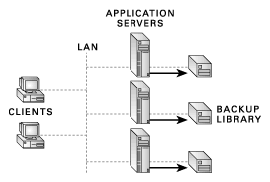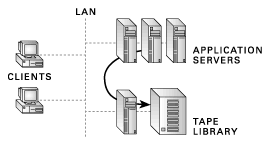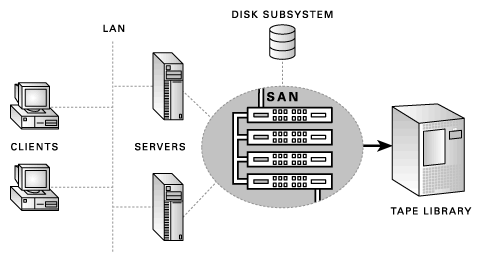| |
SAN Backup solutions
The Internet and e-everything applications have driven data storage requirements sky-high.
Systems and network administrators are struggling to cope with huge increases in both the amount of data being created and the number of locations (servers, desktops, RAIDs) where it is being stored. Charged with protecting their companies’ most valuable asset, administrators are faced with less time for backup as demands for expanded access to critical data are also rising.
Storage Area Networks is the solution to your headaches. If you plan to consolidate enterprise data and take advantage of Storage Area Networks (SANs), putting in place a SAN Backup solution will provide one of the greatest benefits of your SAN environment. A SAN backup solution lets you consolidate backup data, speeds up your backup, and frees important LAN (Ethernet) resources.
Unylogix can provide solutions with everything you need to access and backup your data using scalable, cost-effective SAN technology: FibreReadyTM tape libraries, appropriate SAN-ready software, routers, hubs, switches, host bus adapters, and cabling.
Unylogix can provide a fully certified, interoperable backup system based on open, industry-standard SAN products, complete with single-source, 24 x 7 technical support.
Our non-proprietary SAN backup solution is designed to consolidate data protection across heterogeneous enterprise networks.
First, let's take a look at the evolution of backup models.
Free Up More Resources - Backup off the Network
In conventional backup schemes, high performance data transfer is achieved in various ways: by multiple tape drives or autoloaders locally attached to multiple servers, by attaching a tape library directly to a single backup server, with data from other servers being brought over the network to the direct-attached server. For high volumes of data, these architectures increase the management & complexity of backups and clog the network - degrading backup, overall system performance and management flexibility.
Traditional Distributed Model
Traditionally, backup was accomplished
using tape drives connected directly to
servers. As the number of servers proliferated,
managing the tapes became a significant
challenge. Tapes had to be labeled, cataloged,
loaded, unloaded and transported
between their storage locations and the drives.
Distributed backup offers high speed and network performance. However, since data is stored in isolated systems throughout the network, the cost to manage and scale this model will rise as data demands increase.

Traditional Backup over the LAN
The advent of faster networks made
it feasible to move backup data across the
LAN to a central server equipped
with an automated tape library, eliminating
locally attached tape drives and manual
media management and it’s attendant
problems. Centralized backup using tape
libraries has become the standard
operating mode for most medium and
all large enterprises.
Backup over the LAN offers centralized data storage and control. However, network speed and performance will decrease as network traffic increases, particularly in organizations that provide 24x7 network data services.

SAN Backup Best of Both Worlds
Increasing LAN traffic from user applications
and rapidly growing data movement
requirements have outstripped the network’s
capability. Storage Area Networks
(SANs), are designed specifically to move
data files between storage devices like
RAIDs and tape libraries, and servers. A SAN combines
the benefits of network connectivity with
the high speed and long transmission distance that Fibre Channel
technology connectivity yields. A SAN
implementation will also substantially
improve LAN performance for all users by
moving file transfers off of the LAN, onto a
separate network that is optimized for
such transfers - therefore freeing your network for critical business transactions while reducing backup times significantly.
A SAN Backup offers all the benefits of traditional models - with none of the drawbacks.
Backup data is consolidated in a library of shared tape drives, where you can centralize data control and scale storage easily and economically. No matter which backup configuration you use now, our backup experts can help your organization achieve a smooth, low-risk transition to efficient, cost-effective SAN Backup.

Fibre Channel Backup Has Arrived
Sharing backup resources in Fibre Channel Storage Area Networks (SANs) provides a practical solution to some of the most difficult backup problems facing IT managers.
Sharing backup resources with Fibre Channel SANs offers the advantages of:
- Increased performance, LAN-free backups
- Increased fault tolerance
- Consolidated storage management functions
- Easy performance and capacity scalability
Sharing backup resources means several things in a Fibre Channel SAN. Fundamentally, the architecture creates what is effectively a direct connection between each of the servers and the shared backup device. Inside the tape library, both media and drives can be shared in media and drive “pools,” with any number of servers using them. The devices that make this sharing possible are the Fibre Channel hubs that arbitrate the data from the servers, and the ADIC Fibre Channel-SCSI routers that allow SCSI signals to be carried over the SAN. In the case of ADIC’s Fibre Channel-ready tape libraries, the need for a separate router is eliminated. Also critical to SAN operation is the management and arbitration which is controlled by the backup software application.
Increased performance, both for the backup and the LAN. Each server can have the kind of performance that is normally reserved for directly connected devices in conventional backup, and the LAN is removed as a data transfer bottleneck. The result is that the time to backup the aggregated data from the group of servers is dramatically reduced. And at the same time, the data traffic
is removed from the LAN so its performance remains high as well.
Major increase in fault tolerance. Shared devices and drive pools mean that each server can have a wider range of resources to draw on, and as a consequence backup and recovery is inherently better protected from anomalies associated with any single device.
Storage Area Network architecture also makes possible a greater degree of centralization of storage resources. Part of this occurs because of the resource sharing and part because Fibre Channel technology allows transfer of data at direct-connect speeds at distances of up 10,000 meters per link. Centralizing resources makes it easier to manage storage, easier to ensure that
backup is secure, and easier to control data restores.
Fibre Channel SAN architecture creates major advances in system scalability, both for capacity and for performance. When more capacity or performance is needed, it is easy to simply add additional storage devices or to expand existing tape library systems. The additional drives, media slots, or libraries are available for all of the servers in the SAN without major system re-architecture.
More About Fibre Channel
Fibre Channel Basics
Fibre Channel makes a SAN possible by
allowing large numbers of devices to be
connected across relatively long distances,
while still delivering high data rates. For
example, a Fibre tape library dedicated
to mirroring backup for disaster recovery
can be located across town from the data
center and still be able to transfer data as if
it were locally connected to the backup
server in the data center.
Four different carrier mediums are available
to match the transmission distance
required while providing the most cost-effective
connection. Copper cables up to
25 meters and optical fiber cables up to
10 kilometers all deliver ~100 MB/second
data rates.
FC-AL SAN
SANs can be configured in either arbitrated
loop (FC-AL) or fabric topologies. (Fibre
Channel can also be used in point-to-point
applications between two devices.) FC-AL
allows up to 126 nodes to be linked together.
In this configuration, all nodes share the
available bandwidth of the loop, thus
adding nodes will impact the delivered data
rate to a particular node.
In FC-AL implementations, data
passes around the loop, from node to node,
until it reaches its target. Normally, the
physical connection of devices to the Fibre
Channel is accomplished through hubs.
Hubs concentrate connections from several
nodes into one Fibre Channel connection,
saving money and allowing nodes to be
connected or disconnected without interrupting
the data flow on the loop.
Switched Fabric SAN
A SAN fabric topology employs switches
to provide a number of simultaneous connections
between the devices involved in a specific
data transfer. For example, a server can be
transferring data to a library at 100 megabytes
per second, while a RAID is transferring a file
to another server at the same data rate. Since
bandwidth is not shared, the overall throughput
of the SAN increases significantly.
SCSI over Fibre Channel
Tape drives and libraries use SCSI commands
to communicate with servers. All storage management
applications expect to be communicating
with tape devices using the SCSI protocol.
A module called a bridge or router is
required to translate SCSI and Fibre
Channel commands. Various solutions exist from tape library built-in bridge/router to external connected solutions.
As an example, one of our solutions includes a
library-bridge that provides three Ultra2 SCSI
busses to insure maximum performance.
If the tape library holds eight or more tape drives it
can utilize two independent bridges, which
can be addressed as one or two nodes on the
same loop or separately on different loops.
As SCSI peripheral devices require bridges to
communicate over Fibre Channel, servers
also need appropriate SCSI-to-FC connections.
Host Bus Adapters (HBAs) provide
this interface, typically in PCI-format cards
that are designed for specific systems.
Several manufacturers provide models that
offer various physical interfaces, features
and levels of performance.
Implementation
Implementing a Fibre Channel-based SAN
will soon become as straightforward as setting
up SCSI busses. Each component has
several suppliers vying to become the market
leader in their specific niche. At the present
time, however, the hub, switch, bridge
and HBA manufacturers and the application
developers are working hard to raise the
level of interoperability between their
products. All suppliers provide support
lists that reflect the work already completed
to guide component selection. Unylogix can help provide the proper solution be ensure that interoperability problems do not complicate
the SAN installation.
Implement your SAN Backup solution today
Like many new technologies, SAN and Fibre
Channel have been hyped to the skies, with
promises of nirvana for those brave souls
astute enough to grasp the vision.
Overblown expectations aside, the technology
will deliver solid results when properly
planned and implemented. Unylogix SAN Backup products will help you implement an approriate solution in all SAN topologies and interoperate
with most components and applications.
For more detailed information about fibre channel fundamentals including key features of fibre channel, how it works, why the need for fibre channel, how to build a real fibre channel environment, etc, please click here.
|